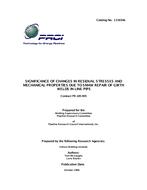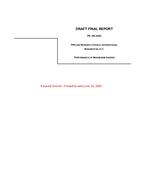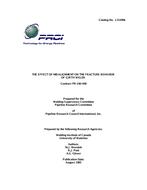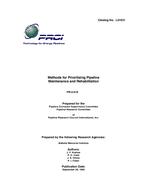Provide PDF Format
PRCI PR-185-905
- Significant of Changes in Residual Stresses and Mechanical Properties Due to SMAW Repair of Girth Welds in Line Pipe
- Report / Survey by Pipeline Research Council International, 10/01/1990
- Publisher: PRCI
$48.00$95.00
L51634e
Edison Welding Institute
Need: There is a periodic requirement for immediate weld repairs during all pipe-laying operations. This need arises due to the occasional occurrence of girth weld flaws, which exceed specified defect tolerance levels. These defects are most commonly discovered by on-site radiographic inspection techniques and may be voids, inclusions and geometric irregularities. Repair welding may be required only over a limited portion of the pipe circumference and access for carrying out the repair may be restricted. Due to the range of types of repairs carried out and the limited time scales available, it is common for the weld repair procedures to be less well documented than the girth weld procedures. In particular, the welding procedure may not have been qualified with the same thoroughness and attention to detail as was the girth welding procedure.
Weldments typically contain high residual stresses. The primary source of these residual stresses is the differential contraction, which occurs as a weldment cools. This contraction is restrained by the surrounding cooler material resulting in the weld metal being placed in tension with balancing areas of compression in the surrounding material. The input of additional thermal energy due to a repair in a highly restrained region may create a new residual stress pattern around the repair. Mechanical properties, especially toughness, may be adversely affected in the region near the repair.
Result: This program assessed the effects of SMAW repair welding on changes in surface residual stress distribution; fracture toughness and hardness around girth weld joints in line pipe. The following types of repair welds were studied: a part wall repair, a multiple part wall repair and full wall repair. The results were compared with a non-repaired weld sample. It was found that for the weld samples studied in this program, the full wall repair produced the most severe residual stress distribution followed by the multiple and single part wall repairs. The single repair only slightly increased the residual stress distribution when compared to the as-welded condition. Dramatic reductions in toughness were found in the multiple and full wall repairs due to coarse-grained regions produced during the repair operations. The single part wall repair exhibited an increase in toughness as a result of the addition of a cosmetic capping pass that resulted in greater grain refinement. This suggests that repair procedures utilizing a stringer or temper bead technique may reduce the effect of weld repairs on toughness.
Benefit: This program was a limited study on the effect of repair welding on pipeline structural integrity. To fully assess the effects of repair welding, further studies investigating various combinations of pipe materials, welding procedures and consumables are necessary.
Edison Welding Institute
Need: There is a periodic requirement for immediate weld repairs during all pipe-laying operations. This need arises due to the occasional occurrence of girth weld flaws, which exceed specified defect tolerance levels. These defects are most commonly discovered by on-site radiographic inspection techniques and may be voids, inclusions and geometric irregularities. Repair welding may be required only over a limited portion of the pipe circumference and access for carrying out the repair may be restricted. Due to the range of types of repairs carried out and the limited time scales available, it is common for the weld repair procedures to be less well documented than the girth weld procedures. In particular, the welding procedure may not have been qualified with the same thoroughness and attention to detail as was the girth welding procedure.
Weldments typically contain high residual stresses. The primary source of these residual stresses is the differential contraction, which occurs as a weldment cools. This contraction is restrained by the surrounding cooler material resulting in the weld metal being placed in tension with balancing areas of compression in the surrounding material. The input of additional thermal energy due to a repair in a highly restrained region may create a new residual stress pattern around the repair. Mechanical properties, especially toughness, may be adversely affected in the region near the repair.
Result: This program assessed the effects of SMAW repair welding on changes in surface residual stress distribution; fracture toughness and hardness around girth weld joints in line pipe. The following types of repair welds were studied: a part wall repair, a multiple part wall repair and full wall repair. The results were compared with a non-repaired weld sample. It was found that for the weld samples studied in this program, the full wall repair produced the most severe residual stress distribution followed by the multiple and single part wall repairs. The single repair only slightly increased the residual stress distribution when compared to the as-welded condition. Dramatic reductions in toughness were found in the multiple and full wall repairs due to coarse-grained regions produced during the repair operations. The single part wall repair exhibited an increase in toughness as a result of the addition of a cosmetic capping pass that resulted in greater grain refinement. This suggests that repair procedures utilizing a stringer or temper bead technique may reduce the effect of weld repairs on toughness.
Benefit: This program was a limited study on the effect of repair welding on pipeline structural integrity. To fully assess the effects of repair welding, further studies investigating various combinations of pipe materials, welding procedures and consumables are necessary.
Related Products
PRCI PR-186-0025
Development of Quality and Performance Specifications For Magnesium Anodes..
$148.00 $295.00
PRCI PR-273-0135
Gas Decompression Behavior Following the Rupture of High Pressure Pipelines - Phase 1..
$6.00 $12.00





